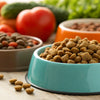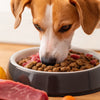Is Kibble Necessary for Dogs? Exploring the Best Diet for Our Furry Friends
- Houndsy
Table of Contents
- Introduction
- The Evolution of Dog Food
- Understanding Kibble: What Is It?
- Pros and Cons of Feeding Kibble
- Fresh and Raw Diets: A Closer Look
- Making the Right Choice for Your Dog
- Enhancing the Feeding Experience with Houndsy
- Conclusion
Introduction
Did you know that nearly 60% of dogs in the U.S. are classified as overweight or obese? This alarming statistic raises a crucial question for pet owners everywhere: Is kibble necessary for dogs? With the increasing awareness of pet nutrition, many dog owners are re-evaluating their pets' diets, particularly the longstanding reliance on kibble.
As pet lovers ourselves, we understand the weight of this decision. We want to ensure our canine companions receive the best possible nutrition to promote their health and happiness. In this blog post, we will explore the pros and cons of kibble, compare it with other dietary options, and delve into how our flagship product, the Houndsy Kibble Dispenser, fits into this equation.
By the end of this comprehensive guide, you will have a clearer understanding of whether kibble is the best choice for your dog, and how to optimize your pet's feeding routine for their unique needs.
The Evolution of Dog Food
Historically, dog food has come a long way. In the early days, dogs were often fed table scraps or whatever their owners had on hand. This changed in the mid-20th century with the introduction of commercially manufactured kibble, which promised convenience and nutrition in a single package. But as pet owners, we now face a plethora of options, including raw diets, fresh food, and high-quality kibble.
The Rise of Kibble
Kibble gained popularity due to its affordability, ease of storage, and long shelf life. It’s convenient for busy pet parents who may not have the time to prepare fresh meals daily. However, there are growing concerns about the nutritional value of kibble, especially as studies show that high-heat processing can strip essential nutrients from ingredients.
Alternatives to Kibble
With the rise in pet health awareness, alternative diets such as fresh food, raw diets, and mixed meal options are gaining traction. Fresh food delivery services are making it easier than ever for pet owners to provide their dogs with high-quality, nutritious meals. Each option comes with its own set of pros and cons, which we will explore in detail.
Understanding Kibble: What Is It?
Kibble is essentially dry dog food made from a mixture of ingredients such as meat, grains, vegetables, and vitamins. The ingredients are combined, cooked, and shaped into bite-sized pieces. While kibble is designed to meet a dog’s nutritional needs, the quality of ingredients can vary widely between brands.
Key Ingredients in Kibble
- Protein Sources: The type of protein used is critical. High-quality brands usually specify a single protein source, while lower-quality brands may use generic terms like "meat meal" or "animal by-products."
- Grains and Carbohydrates: Kibble often contains grains like corn, wheat, or soy. While some dogs may digest these well, others can have sensitivities.
- Vitamins and Minerals: Many kibbles are fortified with synthetic vitamins and minerals to replace those lost during the cooking process.
The Nutritional Profile of Kibble
Most kibble is designed to be nutritionally complete, adhering to standards set by organizations like the Association of American Feed Control Officials (AAFCO). However, the high-heat processing can lead to nutrient degradation, making it essential for dog owners to choose high-quality options.
Pros and Cons of Feeding Kibble
Pros of Kibble
- Convenience: Kibble is easy to store and serve, making it a popular choice for busy pet owners.
- Cost-Effective: Generally, kibble is more affordable than fresh or raw diets.
- Dental Health: Crunchy kibble can help reduce plaque and tartar buildup on dogs' teeth.
- Long Shelf Life: Kibble can be stored for extended periods without spoiling.
Cons of Kibble
- Low Moisture Content: Kibble is dry, which can lead to dehydration if dogs do not drink enough water.
- Quality Variation: Not all kibble is created equal; lower-quality brands may contain fillers and low-grade ingredients.
- Digestive Issues: Some dogs have difficulty digesting kibble, especially those with sensitive stomachs or food allergies.
- Potential Health Risks: High-carb diets can contribute to obesity and related health issues in dogs.
Fresh and Raw Diets: A Closer Look
As we consider whether kibble is necessary for dogs, it's essential to explore alternative diets such as fresh food and raw diets.
Fresh Food Diets
Fresh food diets consist of whole, minimally processed ingredients. Services like Ollie and JustFoodForDogs provide vet-approved meals that are tailored to meet individual dogs' nutritional needs.
Benefits of Fresh Food:
- Higher moisture content promotes hydration.
- Nutrient-rich ingredients support overall health.
- Often more palatable for picky eaters.
Considerations:
- Fresh food can be more expensive than kibble.
- Requires careful handling and storage to avoid spoilage.
Raw Diets
Raw feeding involves providing dogs with uncooked meat, bones, fruits, and vegetables. Advocates argue that this diet mimics what dogs would eat in the wild, leading to better health outcomes.
Benefits of Raw Diets:
- Improved coat condition and energy levels.
- Better digestion and reduced stool volume.
Considerations:
- Risk of bacterial contamination if not handled properly.
- Requires careful planning to ensure balanced nutrition.
Making the Right Choice for Your Dog
So, is kibble necessary for dogs? The answer is not straightforward. It ultimately depends on your dog's individual health needs, lifestyle, and your personal preferences as a pet parent. Here are some factors to consider:
- Consult with Your Veterinarian: Always discuss dietary changes with a professional who understands your dog's health history.
- Evaluate Your Dog’s Activity Level: Active dogs may require different nutritional needs compared to more sedentary pets.
- Consider Food Allergies: If your dog has specific allergies or sensitivities, it may be worth exploring fresh or raw diets.
- Budget and Lifestyle: Consider your budget and how much time you can dedicate to preparing your dog's meals.
Enhancing the Feeding Experience with Houndsy
At Houndsy, we understand the importance of making mealtime enjoyable and convenient for both pet owners and their dogs. Our flagship product, the Houndsy Kibble Dispenser, is designed to take the hassle out of feeding while complementing your home decor.
Features of the Houndsy Kibble Dispenser
- Convenient Crank: Positioned at a standing height to eliminate bending over while serving.
- Perfect Portion Control: Ensures your dog receives the right amount of food every time.
- Stylish Design: Mid-century modern aesthetics that fit seamlessly into any home.
- Large Capacity: Holds up to 30 lbs of kibble, reducing the need for frequent refills.
- BPA-Free Liner: Keeps kibble fresh and safe for your pet.
By investing in a Houndsy Kibble Dispenser, you can simplify your feeding routine while ensuring your dog enjoys their meals in style. Explore the Houndsy Kibble Dispenser here to see how it can transform your pet's feeding experience.
Conclusion
As we've explored, the question of whether kibble is necessary for dogs is nuanced. While kibble offers convenience and affordability, fresh and raw diets may provide superior nutrition for many dogs. Ultimately, the best choice will depend on your dog's unique needs, preferences, and your lifestyle as a pet owner.
We encourage you to reflect on your dog's current diet and consider whether adjustments could improve their health and wellbeing. Remember, incorporating a balanced diet—whether that includes kibble, fresh food, or a combination of both—will have a positive impact on your dog's quality of life.
For those who choose to stick with kibble, consider enhancing the feeding experience with the Houndsy Kibble Dispenser. It can help make mealtime a pleasure for you and your furry friend.
FAQ
Q: Is kibble the only option for feeding my dog?
A: No, there are various options, including fresh food and raw diets. It's important to evaluate what works best for your dog's needs.
Q: How can I transition my dog from kibble to a fresh diet?
A: Gradually introduce fresh food into your dog's diet over a week, mixing it with their kibble to ease the transition.
Q: What should I look for when choosing kibble?
A: Look for a kibble with high-quality ingredients, a specific protein source as the first ingredient, and without fillers.
Q: How does the Houndsy Kibble Dispenser help with feeding?
A: The dispenser offers convenient portion control, stylish design, and easy access to kibble without the mess.
Q: Can I mix kibble with fresh food?
A: Yes, many pet owners find success in mixing kibble with fresh food to provide variety and enhanced nutrition.













